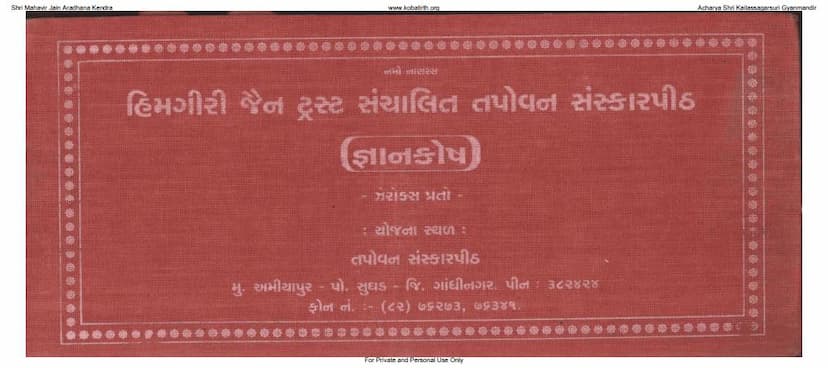Chatvari Prakaranani
Added to library: September 1, 2025

Summary
Here's a comprehensive summary of the Jain text "Chatvari Prakaranani," based on the provided pages:
Book Title: Chatvari Prakaranani (The Four Treatises) Authors: Indrasenvijay Gani, Sinhsenvijay Gani Publisher: Jain Granth Prakashak Sabha, Ahmedabad Date of Publication: Vikram Samvat 2042 / Veer Samvat 2512 / Nemi Samvat 37
Overview:
The book "Chatvari Prakaranani" presents four significant Jain philosophical and cosmological treatises, likely intended for the broader Jain community's education and spiritual upliftment. The publication is supported by various Jain trusts and organizations, highlighting its community-driven nature. The book is dedicated to prominent Jain Acharyas, particularly Acharya Shri Vijay Meruprabh Surishwarji Maharaj Saheb, acknowledging their guidance and inspiration.
Contents of the Four Treatises:
The book comprises four distinct Prakaranas (treatises) as indicated in the table of contents (Page 5):
-
Shri Jiva Vichar Prakaran (Treatise on the Soul): This treatise focuses on the nature, classification, lifespan, vitalities, and other characteristics of the soul (Jiva). It delves into the different types of souls, their origins, and their spiritual journey. The text traces its lineage to Acharya Shrimad Shantisuriji and its commentary to Pathak Ratnakar and Shri Kshama Kalyan. The summary highlights the detailed categorization of souls, including various classifications based on senses, lifespan, consciousness, and spiritual states, referencing ancient Jain scriptures like Jiva-Abhigama Sutra. It meticulously discusses the different types of beings, from one-sensed beings (Ekendriyas) like earth-bodied, water-bodied, fire-bodied, air-bodied, and plant-bodied souls, to two-sensed (Dviendriyas), three-sensed (Triendriyas), four-sensed (Chaturindriyas), and five-sensed (Panchindriyas) beings. It also elaborates on the concept of Jiva based on its various states, such as Siddhas (liberated souls) and Sansarins (souls in the cycle of rebirth), and further breaks down the classifications into subtle and gross, mobile and immobile, and various categories of hell-dwellers, animals, humans, and celestial beings.
-
Shri Navatattva Prakaran (Treatise on the Nine Essentials): This treatise expounds on the nine fundamental principles of Jainism:
- Jiva (Soul)
- Ajiva (Non-soul)
- Puṇya (Merit)
- Pāpa (Demerit)
- Āshrava (Influx of karma)
- Saṁvara (Stoppage of karma)
- Nirjarā (Shedding of karma)
- Bandha (Bondage of karma)
- Moksha (Liberation) The text explains the detailed classifications and sub-classifications within each of these tattvas, leading to a total of 276 sub-categories. The summary emphasizes the importance of understanding these tattvas for achieving right faith (Samyak Darshan) and ultimately liberation. It discusses the profound implications of studying these principles for spiritual progress.
-
Shri Dandaka Prakaran (Treatise on the Categories/Classifications): This treatise explores the concept of "Dandaka," which refers to specific categories of beings or entities in Jain cosmology and philosophy. The text identifies 24 such categories, including hell-dwellers (Narakas), various classes of celestial beings (like Bhavanapatis, Vyantaras, Jyotishkas, Vaimanikas), and different types of one-sensed beings (like earth-bodied, water-bodied, etc.). The summary explains the etymology of "Dandaka" as related to punishment or classification. It also lists 24 "doors" or aspects that are considered important for understanding these categories, such as body, stature, condensation, consciousness, form, passions, color, senses, summation, view, perception, knowledge, ignorance, speed, ascent, descent, duration, movement, conduct, place, coming, and feeling. The text highlights that this particular treatise is also known as "Laghu Sangrahani" (Small Compendium) and is related to the Jambu-dvipa Ksheta Sangrahani.
-
Shri Laghu Sangrahani (Shri Jambudvipa Kshetra Sangrahani) (Treatise on the Lesser Compendium / Geographical Compendium of Jambudvipa): This treatise focuses on the geography and cosmology of Jambudvipa, the central continent in Jain cosmology. It details various aspects of Jambudvipa, including its continents, oceans, mountains, settlements, rivers, and other geographical features. The summary lists ten key elements discussed in this treatise: continents (Khanda), yojanas (measurements), regions (Varsha), mountains, peaks (Kuta), sacred sites (Tirtha), city-rows (Shreni), regions of conquest (Vijaya), lakes (Hrada), and rivers (Nadi). It mentions the foundational text by Acharya Haribhadra Surishwarji and its commentary by Shri Prabhananda Suri. The text provides specific numerical data for these geographical elements within Jambudvipa.
Key Themes and Concepts:
- Comprehensive Jain Doctrine: The book aims to provide a foundational understanding of core Jain teachings, covering the soul, fundamental principles, classifications of beings, and the structure of the cosmos.
- Spiritual Guidance: The emphasis on studying these treatises suggests their importance for spiritual growth, leading to right faith, conduct, and ultimately, liberation.
- Community Support: The detailed acknowledgments of financial and other contributions from various Jain institutions underscore the collaborative effort involved in disseminating Jain knowledge.
- Scholarly Tradition: The book adheres to the traditional Jain scholarly approach by presenting original texts (Moola), commentaries (Vritti), and explanations (Savachurika), often tracing the lineage of teachers and texts.
- Cosmological Detail: The Navatattva and Jambudvipa Sangrahani sections, in particular, demonstrate the intricate and detailed cosmological framework within Jainism.
- Ethical Living: The underlying message promotes righteous conduct, devotion to the teachings of the Jinas, and the pursuit of spiritual knowledge as a path to well-being and ultimate freedom.
In essence, "Chatvari Prakaranani" serves as an educational compendium, making complex Jain philosophical and cosmological concepts accessible to a wider audience through the combined efforts of esteemed Acharyas and dedicated scholars.